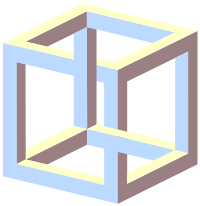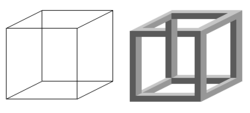Impossible cube
The impossible cube or irrational cube is one of several impossible objects. The impossible cube draws upon the ambiguity present in a Necker cube illustration.
Discovery
The origins of the impossible cube are often attributed to artist M. C. Escher, whose work often featured optical illusions and impossible objects. The impossible cube can be seen in the 1958 lithograph Belvedere, in which a seated man appears to be constructing an impossible cube from the drawing of a Necker cube.
Description
An impossible cube is usually rendered as a Necker cube in which the edges are depicted as solid beams. This apparent solidity gives the impossible cube greater visual ambiguity than the Necker cube, which is much less likely to be perceived as an impossible object. When viewing the impossible cube, all the corners appear to be correct, but the edges of the cube overlap in ways that are not physically possible.
Explanation
The illusion plays on the human eye's interpretation of two-dimensional pictures as three-dimensional objects. Visual perspective is used to create the illusion of depth, but the three edges on the back of the cube are placed in the foreground.
Applications
The impossible cube holds a great deal of fascination for viewers. Variations on the impossible cube have been published and "constructed." One famous example of an impossible cube constructed from wood is a photograph published by C. F. Cochran in the June 1966 issue of Scientific American, where it was called a "Freemish Crate." In reality, the Freemish Crate, as well as all three dimensional impossible cubes, was not actually an impossible cube. Either photographs are doctored, or forms are constructed to look like an impossible cube from one very specific angle, as shown in the drawing to the right.
ReferencesISBN links support NWE through referral fees
- Bool, F.H., J.R. Kist, and F. Wierda. M.C. Escher: His Life and Complete Graphic Work (With a Fully Illustrated Catalogue) September 1992. Harry N. Abrams, Inc. ISBN 0810981130
- Gregory, Richard L. 1997. Eye and Brain. Princeton, NJ: Princeton University Press. ISBN 0691048371
- Robinson, J. O. 1998. The Psychology of Visual Illusion. Dover Publications. ISBN 978-0486404493
- Seckel, Al. Optical Ilusions: The Science of Visual Perception. September 2006. Firefly Books. ISBN 1554071720
- Schattschneider, Doris and Michele Emmer. M.C.Escher's Legacy: A Centennial Celebration September 2005. Springer. ISBN 3540201009
Credits
New World Encyclopedia writers and editors rewrote and completed the Wikipedia article in accordance with New World Encyclopedia standards. This article abides by terms of the Creative Commons CC-by-sa 3.0 License (CC-by-sa), which may be used and disseminated with proper attribution. Credit is due under the terms of this license that can reference both the New World Encyclopedia contributors and the selfless volunteer contributors of the Wikimedia Foundation. To cite this article click here for a list of acceptable citing formats.The history of earlier contributions by wikipedians is accessible to researchers here:
The history of this article since it was imported to New World Encyclopedia:
Note: Some restrictions may apply to use of individual images which are separately licensed.


